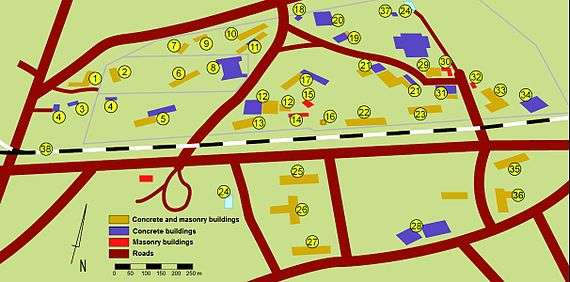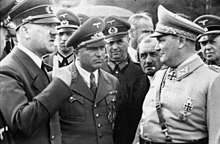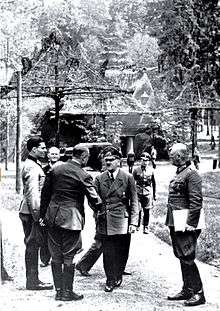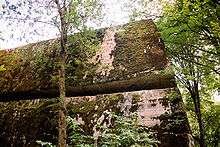Wolf's Lair
The Wolf's Lair (German: Wolfsschanze; Polish: Wilczy Szaniec) was Adolf Hitler's first Eastern Front military headquarters in World War II.[1] The complex, which became one of several Führerhauptquartiere (Führer Headquarters) in various parts of Central and Eastern Europe, was built for the start of Operation Barbarossa—the invasion of the Soviet Union—in 1941. It was constructed by Organisation Todt.[1]
| Wolf's Lair | |
|---|---|
Wolfsschanze | |
| Part of Führerhauptquartiere | |
| present-day Gierłoż, Poland | |
Hitler's reinforced bunker at the Wolfsschanze | |
| Coordinates | 54.0804°N 21.4941°E |
| Type | Camouflaged concrete bunkers |
| Site information | |
| Owner | Polish Government |
| Open to the public | Yes |
| Condition | Mostly destroyed |
| Site history | |
| Built | 1941 |
| Built by | Hochtief AG, Organisation Todt |
| In use | June 1941 – January 1945 |
| Materials | 2 m (6 ft 7 in) steel-reinforced concrete |
| Fate | Partially demolished by retreating German forces |
| Events | 20 July Plot |
| Garrison information | |
| Past commanders | Johann Rattenhuber |
| Garrison | |
| Occupants | |
The top-secret, high-security site was in the Masurian woods about eight kilometres (five miles) east of the small East Prussian town of Rastenburg, in present-day Poland. Three security zones surrounded the central complex where the Führer's bunker was located. These were guarded by personnel from the SS-Begleitkommando des Führers, Reichssicherheitsdienst and the Wehrmacht's armoured Führerbegleitbrigade. Despite the security, the most notable assassination attempt against Hitler was made at Wolf's Lair on 20 July 1944.[1]
Hitler first arrived at the headquarters on 23 June 1941. In total, he spent more than 800 days at the Wolfsschanze during a 3 1⁄2-year period until his final departure on 20 November 1944.[1] In mid-1944, work began to enlarge and reinforce many of the Wolf's Lair original buildings. The work was never completed because of the rapid advance of the Red Army during the Baltic Offensive in late 1944. On 25 January 1945, the complex was blown up and abandoned 48 hours before the arrival of Soviet forces.[1]
Name
Wolfsschanze is derived from "Wolf", a self-adopted nickname of Hitler. He began using the nickname in the early 1930s and it was often how he was addressed by those in his intimate circle. "Wolf" was used in several titles of Hitler's headquarters throughout occupied Europe, such as Wolfsschlucht I and II in Belgium and France and Werwolf in Ukraine.
Although the standard translation in English is "Wolf's Lair," a Schanze in German denotes a sconce, redoubt or temporary fieldwork.
Layout
The decision was made in late 1940 to build Wolf's Lair in the middle of a forest, far from major roads and urban areas. The 6.5 km2 (2 1⁄2 sq mi) complex was completed by 21 June 1941 and consisted of three concentric security zones.[2] About two thousand people lived and worked at Wolf's Lair at its peak, among them twenty women,[2] some of whom were required to eat Hitler's food to test for poison.[3]
The installations were served by a nearby airfield and railway lines. Buildings within the complex were camouflaged with bushes, grass, and artificial trees on the flat roofs; netting was also erected between buildings and the surrounding forest so that the installation looked like unbroken dense woodland from the air.[2]
- Sperrkreis 1 (Security Zone 1) was located at the heart of the Wolf's Lair, the perimeter was ringed by steel fencing and guarded by the SS Reichssicherheitsdienst (RSD). Within the compound, security was managed by Dienststelle I (command I) from the SS-Begleitkommando des Führers (FBK) which operated under the auspices of Obersturmbannführer Bruno Gesche. These were the only armed guards Hitler allowed to be near him.[4] They never had to surrender their weapons and were never searched whereas the RSD were required to remain at positions some distance away from Hitler.[5] The zone contained the Führer Bunker and ten other camouflaged bunkers built from 2-metre-thick (6 ft 7 in) steel-reinforced concrete. These shelters protected members of Hitler's inner circle such as Martin Bormann, Hermann Göring, Wilhelm Keitel, and Alfred Jodl. Hitler's accommodation was on the northern side of Führer Bunker so as to avoid direct sunlight. Both Hitler's and Keitel's bunkers had additional rooms where military conferences could be held.[1]
- Sperrkreis 2 (Security Zone 2) surrounded the inner zone. This area housed the quarters of several Reich Ministers such as Fritz Todt, Albert Speer, and Joachim von Ribbentrop. It also housed the quarters of the personnel who worked in the Wolf's Lair and the military barracks for the RSD.
- Sperrkreis 3 (Security Zone 3) was the heavily fortified outer security area which surrounded the two inner zones. It was defended by land mines and the Führerbegleitbrigade (FBB), a special armoured security unit from Wehrmacht which manned guardhouses, watchtowers, and checkpoints.
A facility for Army headquarters was also located near Wolf's lair complex.[1] The FBK and RSD had responsibility for Hitler's personal security within the Wolf's Lair while external protection of the complex was provided by the FBB, which had become a regiment by July 1944. The FBB was equipped with tanks, anti-aircraft guns, and other heavy weapons. Any approaching aircraft could be detected up to 100 km (60 mi) from the Wolf's Lair. Additional troops were also stationed about 75 km (45 mi) away.[2]

|
1. Office and barracks of Hitler's bodyguard 2. FBK/RSD command post 3. Emergency generator 4. Bunker 5. Office of Otto Dietrich, Hitler's press secretary 6. Conference room, site of the 20 July 1944 assassination attempt 7. RSD command post 8. Guest bunker and air-raid shelter 9. RSD command post 10. Secretariat under Philipp Bouhler 11. Headquarters of Johann Rattenhuber, SS chief of Hitler's security department, and Post Office 12. Radio and telex buildings 13. Vehicle garages |
14. Railway siding for Hitler's Train 15. Cinema 16. Generator buildings 17. Quarters of Morell, Bodenschatz, Hewel, Voß, Wolff, and Fegelein 18. Stores 19. Residence of Martin Bormann, Hitler's personal secretary 20. Bormann's personal air-raid shelter for himself and staff 21. Office of Hitler's adjutant and the Wehrmacht's personnel office 22. Military and staff mess II 23. Quarters of General Alfred Jodl, Chief of Operations of OKW 24. Firefighting pond 25. Office of the Foreign Ministry 26. Quarters of Fritz Todt, then Albert Speer after Todt's death |
27. RSD command post 28. Air-raid shelter with Flak and MG units on the roof 29. Hitler's bunker and air-raid shelter 30. New tea room 31. Residence of General Field Marshal Wilhelm Keitel, supreme commander of OKW 32. Old tea house 33. Residence of Reich Marshal Hermann Göring 34. Göring's personal air-raid shelter for himself and staff, with Flak and MG on the roof 35. Offices of the High Command of the Air Force 36. Offices of the High command of the Navy 37. Bunker with Flak 38. Ketrzyn railway line |
Reinforcements

Hitler's secretary Traudl Junge recalled that Hitler repeatedly spoke in late 1943 or early 1944 of a possible bomber attack on the Wolfsschanze by the Western Allies. She quoted Hitler as saying, "They know exactly where we are, and sometime they’re going to destroy everything here with carefully aimed bombs. I expect them to attack any day." [6]
According to Speer, between 28 July 1941 and 20 March 1942, Hitler left Rastenburg only four times for a total of 57 days. Afterwards, Hitler spent the next three months in Obersalzberg before returning to Rastenburg for the next nine months.[7]
Hitler's entourage returned to the Wolfsschanze from an extended summer stay at the Berghof in July 1944. The previous small bunkers had been replaced by the Organisation Todt with "heavy, colossal structures" of reinforced concrete as defense against the feared air attack.[8] According to Armaments Minister Albert Speer, "some 36,000,000 marks were spent for bunkers in Rastenburg [Wolf's Lair]." [9]
Hitler's bunker had become the largest, "a positive fortress" containing "a maze of passages, rooms and halls." Junge wrote, "We had air-raid warnings every day" in the period between the 20 July assassination attempt and Hitler's final departure from the Wolfsschanze in November 1944, "but there was never more than a single aircraft circling over the forest, and no bombs were dropped. All the same, Hitler took the danger very seriously, and thought all these reconnaissance flights were in preparation for the big raid he was expecting."[10]
No air attack ever came. It has never been revealed whether the Western Allies knew of the Wolfsschanze's location and importance. The Soviet Union was unaware of both the location and the scale of the complex until it was uncovered by their forces in their advance towards Germany in early 1945.[11]
Hitler's daily routine
Hitler would begin his day when he was in residence by taking a walk alone with his dog around 9 or 10 am, and at 10:30 am he looked at the mail that had been delivered by air or courier train. A noon situation briefing was convened in Keitel's and Jodl's bunker and frequently ran for two hours. This was followed by lunch at 2 pm in the dining hall. Hitler invariably sat in the same seat between Jodl and Otto Dietrich, while Keitel, Martin Bormann, and Göring's adjutant General Karl Bodenschatz sat opposite him.[1]
After lunch, Hitler dealt with non-military matters for the remainder of the afternoon. Coffee was served around 5 pm, followed by a second military briefing by Jodl at 6 pm. Dinner could also last as long as two hours, beginning at 7:30 pm, after which films were shown in the cinema. Hitler then retired to his private quarters where he gave monologues to his entourage, including the two female secretaries who had accompanied him to the Wolf's Lair. Occasionally, Hitler and his entourage listened to gramophone records of Beethoven symphonies, selections from Wagner or other operas, or German lieder.[1]
Notable visitors
- Antonescu, Ion – marshal of Romania[12][13][14]
- Boris III of Bulgaria – tsar of Bulgaria[15][16]
- Bose, Subhas Chandra – independence politician from India[17]
- Bozhilov, Dobri – prime minister of Bulgaria in '43–44[18]
- Ciano, Galeazzo (minister of foreign affairs) – Italy[19][20]
- Csatay von Csatai, Lajos (general, ministry of war) – Hungary[21]
- Gailani, Rashid Ali al- (former prime minister) – Iraq[22]
- Gariboldi, Italo (general) – Italy[23]
- Graziani, Rodolfo (marshal) – Italy[24]
- Horthy, Miklós (regent) – Hungary[25]
- Jany, Gusztáv (general) – Hungary[26]
- Kállay, Miklós (prime minister) – Hungary[27]
- Koburg, Kiril (prince of Bulgaria and Preslav, tsar successor) – Bulgaria[28]
- Kvaternik, Slavko (commander and minister of armed forces) – Croatia[29]
- Laval, Pierre (prime minister of Vichy regime) – France[30]
- Lukash, Konstantin (general, chief of Staff of the Bulgarian Army) – Bulgaria[31]
- Luukkonen, Fanni (army colonel, leader of the voluntary auxiliary organisation for women) – Finland[32]
- Mannerheim, Carl Gustaf (military leader and statesman) – Finland[33]
- Finat y Escrivá de Romaní Mayalde, José (Conde de Mayalde, ambassador to Third Reich) – Spain[34]
- Michov, Nikola (general, minister of war) – Bulgaria[35]
- Moscardó Ituarte, José (general) – Spain[36]
- Mussolini, Benito (il Duce) – Italy[37][38][39][40]
- Nedić, Milan – general and prime minister of Serbia[41]
- Öhquist, Harald – lieutenant general of Finland[42]
- Ōshima, Hiroshi (general, ambassador to Third Reich) – Japan[43][44][45]
- Pavelić, Ante – Poglavnik ("Head") of Croatia[42]
- Tiso, Jozef – Roman Catholic priest and President of Slovakia[46]
- Toydemir, Cemil Cahit – (general) – Turkey[47]
Assassination attempt

In July 1944, an attempt was made to kill Hitler at Wolf's Lair which became known as the 20 July plot. It was organized by a group of acting and retired Heer officers and some civilians who wanted to remove Hitler in order to establish a new government in Germany. After several failed attempts to kill him, Wolf's Lair was chosen as a viable location, despite its security. Staff officer Colonel Claus von Stauffenberg would carry a briefcase bomb into a daily conference meeting and place it just a few feet away from Hitler.
The location was changed to a briefing building (Lagebaracke) on the day of the strategy meeting due to the reconstruction of the Führer Bunker in mid-1944. Stauffenberg's assassination attempt was unsuccessful because of this change in venue, along with several other factors, such as Hitler unexpectedly calling the meeting earlier than anticipated. The bomb exploded at 12:43 pm; the interior of the building was devastated, but Hitler was only slightly injured. Four people died from their wounds, either a few days later or in the months ahead.
Before the bomb detonated, Stauffenberg and his adjutant Lieutenant Werner von Haeften had already begun to leave the Wolfsschanze in order to return to Berlin. Their escape involved passing through various security zones that controlled all access around the site. After a short delay at the RSD guard post just outside Sperrkreis 1, they were allowed to leave by vehicle. The two officers were then driven down the southern exit road towards the military airstrip near Rastenburg.

The alarm had been raised by the time they reached the guardhouse at the perimeter of Sperrkreis 2. According to the official RSHA report, "at first the guard refused passage until Stauffenberg persuaded him to contact the adjutant to the compound commander who then finally authorized clearance". It was between here and the final checkpoint of Sperrkreis 3 that Haeften tossed another briefcase from the car containing an unused second bomb. The two men reached the outer limit of the Wolfsschanze security zones and were allowed to catch their plane back to army general headquarters in Berlin.
The attempted assassination of Hitler at the Wolf's Lair was part of Operation Valkyrie, a covert plan to take control and suppress any revolt in the German Reich following Hitler's death. News arrived from Wolf's Lair that Hitler was still alive, and troops loyal to the Nazi regime quickly re-established control of key government buildings. Von Stauffenberg, his adjutant Werner von Haeften, and several co-conspirators were arrested and shot the same evening outside the Bendlerblock in Berlin.
On 20 August 1944, Hitler personally presented survivors of the bomb blast with a gold "20 July 1944 Wound Badge". Next-of-kin of those killed in the blast were also given this award.
Demise and capture

The Red Army reached the borders of East Prussia during the Baltic Offensive in October 1944. Hitler departed from the Wolf's Lair for the final time on 20 November when the Soviet advance reached Angerburg (now Węgorzewo), 15 km (9 mi) away. Two days later, the order was given to destroy the complex. The demolition took place on the night of 24–25 January 1945, ten days after the start of the Red Army's Vistula–Oder Offensive. Tons of explosives were used; one bunker required an estimated 8,000 kg (18,000 lb) of TNT. Most of the buildings were only partially destroyed due to their immense size and reinforced structures.
The Red Army captured the abandoned remains of the Wolfsschanze on 27 January without firing a shot, the same day that Auschwitz was liberated farther south. It took until 1955 to clear over 54,000 land mines that surrounded the installation.[2]
Historical site
The area was cleared of abandoned ordnance such as land mines following the war, and the entire site was left to decay by Poland's Communist government. The Wolf's Lair has been developed as a tourist attraction since the Fall of Communism in the early 1990s. Visitors can make day trips from Warsaw or Gdańsk.[48] Hotels and restaurants have grown up near the site.[49] Plans have periodically been proposed to restore the area, including the installation of historical exhibits.[50]
As of 2019, the site was drawing almost 300,000 visitors a year. The Srokowo Forest District, which manages the site, announced plans to upgrade the area. These include a new entrance building, a new car park, and new information panels. The District is also considering building a hotel and restaurant, and staging re-enactments with static figures in Nazi uniforms.
Critics worried that the planned changes could turn the site into a place for neo-Nazi pilgrimages, although the District's spokesperson said that they would "make every effort" to maintain "due seriousness and respect for historical truth". Pawel Machcewicz, a Polish historian who specializes in World War II, said that "[T]he scars left by the war should be preserved and presented as a lesson, a warning. ... Exhibitions should explain the history, contextualise the place, but not completely overshadow it."[51]
See also
References
Footnotes
- Kershaw 2000
- "Location and construction of Wolf's Lair - Why Gierloz / Ketrzyn?".
- Claire Cohen (18 September 2014). "Last surviving female food taster, 96: 'I never saw Hitler, but I had to risk my life for him every day'". Daily Telegraph. Retrieved 19 September 2014.
- Felton, Mark (2014). Guarding Hitler: The Secret World of the Führer. London: Pen and Sword Military. p. 104. ISBN 978-1-78159-305-9.CS1 maint: ref=harv (link)
- Misch, Rochus (2014) [2008]. Hitler's Last Witness: The Memoirs of Hitler's Bodyguard. London: Frontline Books-Skyhorse Publishing, Inc. pp. 120–121. ISBN 978-1848327498.CS1 maint: ref=harv (link)
- Junge, Traudl (2003). Until the Final Hour. Weidenfeld & Nicolson. p. 116.
- Speer, Albert (1995). Inside the Third Reich. London: Weidenfeld & Nicolson. p. 401. ISBN 9781842127353.
- Junge, Traudl. Until the Final Hour. Weidenfeld & Nicolson, 2003, p. 126.
- Speer, A: Inside the Third Reich, p.217
- Junge, Traudl. Until the Final Hour. Weidenfeld & Nicolson, 2003, p. 145.
- Berlin: The Fateful Siege, Antony Beevor
- : pict., publisher (pl): National Digital Archives, 11 February 1942, retrieved 20 September 2013
- : pict., publisher (pl): National Digital Archives, 10–13 January 1943, retrieved 20 September 2013
- : pict., publisher (de): Prussian Heritage Image Archive, 5–6 August 1944, retrieved 20 September 2013
- : pict., publisher (de): Prussian Heritage Image Archive, 24 March 1942, retrieved 20 September 2013
- 14/15.08.1942, : pict., publisher (de): Prussian Heritage Image Archive, retrieved 20 September 2013CS1 maint: numeric names: authors list (link)
- : Image-No.: 50059436 (search inside)., publisher (de): Prussian Heritage Image Archive, 29 May 1942, retrieved 20 September 2013
- : pict., publisher (de): Prussian Heritage Image Archive, 5 November 1943, retrieved 20 September 2013
- : pict., publisher (de): Prussian Heritage Image Archive, 25 October 1941, retrieved 20 September 2013
- : pict., publisher (de): Prussian Heritage Image Archive, 18 December 1942, retrieved 20 September 2013
- : pict., publisher (de): Prussian Heritage Image Archive, 17 August 1943, retrieved 20 September 2013
- : pict., publisher (pl): National Digital Archives, 15 July 1942, retrieved 20 September 2013
- : pict., publisher (de): Prussian Heritage Image Archive, 7 May 1942, retrieved 20 September 2013
- : pict., publisher (de): Prussian Heritage Image Archive, October 1943, retrieved 20 September 2013
- : pict., publisher (pl): National Digital Archives, 8 September 1941, retrieved 20 September 2013
- : pict., publisher (de): Prussian Heritage Image Archive, 16 May 1942, retrieved 20 September 2013
- : pict., publisher (pl): National Digital Archives, 6 June 1942, retrieved 20 September 2013
- : pict., publisher (de): Prussian Heritage Image Archive, 18–19 October 1943, retrieved 20 September 2013
- : pict., publisher (de): Prussian Heritage Image Archive, 21 July 1941, retrieved 20 September 2013
- : pict., publisher (de): Prussian Heritage Image Archive, 19 December 1942, retrieved 20 September 2013
- : pict., publisher (de): Prussian Heritage Image Archive, 8 December 1941, retrieved 20 September 2013
- : pict., publisher (de): Prussian Heritage Image Archive, 26 May 1943, retrieved 20 September 2013
- : pict., publisher (de): Prussian Heritage Image Archive, 27–28 June 1942, retrieved 20 September 2013
- : pict., publisher (de): Prussian Heritage Image Archive, 11 September 1941, retrieved 20 September 2013
- : pict., publisher (de): Prussian Heritage Image Archive, 8 January 1943, retrieved 20 September 2013
- : pict., publisher (de): Prussian Heritage Image Archive, 7 December 1941, retrieved 20 September 2013
- : pict., publisher (de): Prussian Heritage Image Archive, 25 August 1941, retrieved 20 September 2013
- : pict., publisher (de): Prussian Heritage Image Archive, 28 August 1941, retrieved 20 September 2013
- : pict., publisher (de): Prussian Heritage Image Archive, 14 September 1943, retrieved 20 September 2013
- : pict., publisher (pl): National Digital Archives, 20 July 1944, retrieved 20 September 2013
- : pict., publisher (de): Prussian Heritage Image Archive, 18 September 1943, retrieved 20 September 2013
- : pict., publisher (de): Prussian Heritage Image Archive, 30 July 1941, retrieved 20 September 2013
- : pict., publisher (de): Prussian Heritage Image Archive, 15 July 1941, retrieved 20 September 2013
- : pict., publisher (de): Prussian Heritage Image Archive, July 1941, retrieved 20 September 2013
- : pict., publisher (de): Prussian Heritage Image Archive, 4 September 1944, retrieved 20 September 2013
- : pict., publisher (de): Prussian Heritage Image Archive, 20 October 1941, retrieved 20 September 2013
- : pict., publisher (de): Prussian Heritage Image Archive, 6 July 1943, retrieved 20 September 2013
- "How to Visit Wolf's Lair from Warsaw". 13 December 2013.
- "Wolf's Lair sightseeing and tourist attractions - what to see in Wolfsschanze". Archived from the original on 25 March 2015.
- Berendt, Joanna (17 September 2012). "Restoring the Walls, and the History, at Hitler's Wolf's Lair" – via NYTimes.com.
- Peter, Lawrence (31 July 2019) "Wolf's Lair: Will Hitler HQ makeover create a Nazi theme park?" BBC News
Bibliography
- Kershaw, Ian (2000). Hitler, 1936–45. New York: W.W. Norton. ISBN 978-0-393-04994-7.
- Speer, Albert, "Inside the Third Reich", New York and Toronto: Macmillan, 1970, p. 217.
- Junge, Traudl, "Bis Zur Letzten Stunde: Hitlers Sekretärin erzählt ihr Leben", München: Claassen, 2002, pp. 131, 141, 162.
- Junge, Traudl, "Until the Final Hour: Hitler's Last Secretary", London: Weidenfeld & Nicolson, 2003, pp. 116, 126, 145.
- Junge, Traudl, "Voices from the Bunker", New York: G.P.Puttnam's sons, 1989.
External links
| Wikimedia Commons has media related to Wolf's Lair. |